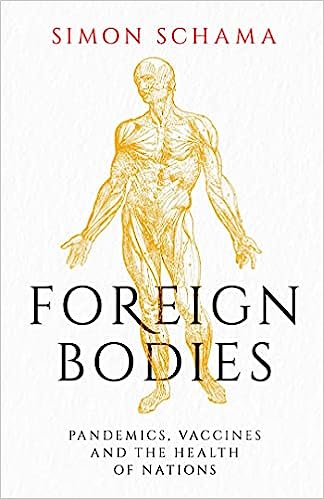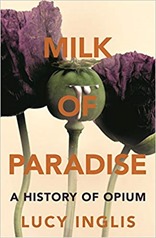My next review is of Foreign Bodies: Pandemics, Vaccines and the Health of Nations by Simon Schama.
The book is divided into three parts, covering smallpox, cholera and bubonic plague – in its late 19th century manifestation – and how vaccines were developed and deployed for these diseases. Waldemar Haffkine features heavily in the chapters on cholera and bubonic plague, for which he invented and delivered vaccines, and in some senses this is his biography albeit somewhat unfocussed with much additional material.
The first part covers the introduction of inoculation for smallpox to Western Europe in the early 18th century. This a process whereby a small quantity of the material from a smallpox pustule is introduced to small cuts in the skin of a patient who then falls mildly ill with the disease but is protected from further more serious infection. Voltaire appears in this section as a hook for some of the discussion – he was one of the early promoters of inoculation in France.
Terms are a bit fluid in this area but inoculation refers to the use of the live, unaltered bacteria/virus whilst vaccination refers to the use of a vaccine which is based on a weakened or even partial version of the disease causing micro-organism.
Smallpox was a serious disease in the 18th century, having apparently mutated to a more virulent, deadly form in the mid-17th century. This newer variant killed as many as 1 in 6 of those infected with many of those surviving showing significant scarring. It was indiscriminate, killing royalty as well as paupers. The inoculation process had been used by at least some communities in the Middle East, Africa and South America. The first chapter in this section is largely about the introduction of the idea of inoculation to polite Western European society. This met with some resistance – inoculation did not fit with the then current model of the smallpox disease (essentially the side effect of a bodily purging process), and it challenged the medical establishment coming as it did from a “foreign” country and, worse than that, was often practiced by women!
The second of the smallpox chapter covers the commercialisation of the inoculation process during the 18th century. This typically involved upselling preliminary treatments and post-inoculation care which was largely superfluous. It is interesting though that as part of this process the first clinical trials were conducted to test the efficacy of the process.
The second part of the book, on cholera, features Adrien Proust, father of Marcel Proust. Adrien Proust would become very involved in creating international the first public health organisations. Cholera had come to Europe around 1817 with pandemics killing many thousands recurring through the century. Proust senior had been a young doctor in the 1854 outbreak in Paris as a hospital doctor he would have seen 40% of patients die from this disease. At the time the cause of cholera was not known, it was assumed that it was a result of “filth” and unsanitary living conditions. This perhaps explains some of the Victorian efforts to install sewers and water systems, as well as the fact that living in crowded insanitary cities was simply unpleasant.
In the case of cholera, which is a bacterial infection discovered (quietly) by Filippo Pacini in 1854 and more famously by Robert Koch in 1883, sanitation and disinfection measures are a reasonable approach which has some benefits. There was commercial opposition to seeing cholera as an infection because that implied quarantines and the like which had a commercial impact. This attitude was to recur in the subsequent bubonic plague outbreaks in Indian and China which has more serious consequences since dirty water has no bearing on plague transmission. In fact we saw this argument regarding the COVID-19 restrictions.
It is in this part we first meet Waldemar Haffkine, born into a Jewish family in Odessa in 1860. He trained as a biologist working under Ilya Mechnikov, who would later win a Noble Prize for his work on immunity. Haffkine went on to the Pasteur Institute in Paris (Pasteur was still alive at this point), where he developed a vaccine for cholera. Haffkine had a an extensive file with the authorities in Odessa as a result of his activism in the defence of the Jewish community against repeated pogroms.
He tested his vaccine in India with minimal support from the colonial medical services. Reading between the lines it looks like his expenses claims were a key historical resource. To a degree he used the Indian population as one amenable for doing controlled trials of the vaccine due to their living conditions, and their status in the colonial system.
The part of the book on bubonic plague is a repeat of the chapters on cholera with Haffkine involved in the discovery of the plague bacillus, and the development and deployment of the vaccine, particularly in India. Here the story diverges a bit, the colonial response to plague was to apply sanitation measures up to and including burning down houses where infections had occurred. This, naturally, angered the local population and played some part in the rise of Indian nationalism.
Haffkine’s medical career was to effectively come to an end in the Indian plague vaccination programme. A vial of vaccine that had been produced in the facility he led was contaminated with tetanus leading to the death of nineteen vaccine recipients. The colonial Indian medical authorities were quick to place the blame on Haffkine although later investigations showed that the vial was most likely contaminated “in the field” (literally) and so was not at all Haffkine’s responsibility. He was eventually notationally exonerated with the support of Sir Ronald Ross (who won a Noble prize for his work on the transmission of malaria) but the damage was done and after some work on a typhoid vaccine he gave up his medical work aged 54.
Haffkine, in his later years, returned to his Jewish roots – arguing the case for Orthodox Judaism, and supporting a movement to make Crimea an area for training Jews in agriculture with a view to moving to Palestine. After the Russian revolution Jews no longer faced pogroms on the basis of their religion, they experienced persecution because the Soviet Union did not want anyone, regardless of religion practicing their religion.
I have mixed feelings about this book, it feels like it is trying to be several things at once – a history of vaccination for smallpox, cholera and bubonic plague but also a biography of Waldemar Haffkine with substantial chunks of not entirely relevant material also added. The long chapters don’t suit my reading style very well. At one point Schama manages a half-page sentence which I don’t think I’ve seen before in English! The book is clearly well-researched and written with some style but it doesn’t feel like a book to be read by the pool.


 Pale Rider: The Spanish Flu and How it Changed the World by Laura Spinney
Pale Rider: The Spanish Flu and How it Changed the World by Laura Spinney Milk of Paradise
Milk of Paradise